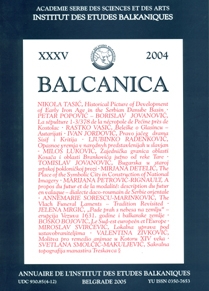Beleške o Glasincu – Autarijati
Notes on Glasinac – The Autariatae
Author(s): Rastko VasićSubject(s): Archaeology
Published by: Balkanološki institut - Srpska akademija nauka i umetnosti
Keywords: Glasinac; the Autariatae; tribe; illyrian tribes;
Summary/Abstract: The Greek Geographer Strabo says the Autariatae used to be the largest and the strongest of Illyrian tribes. The historical context in which they are mentioned is dated to the second half of the fourth century BC, but the tribe is described as neither strong nor large. After that date, there is no further record of them. Therefore the inference seems reasonable that their acme should be dated to a period prior to the fourth century BC. According to archaeologists and modern historians, the Autariatae lived in south-eastern Bosnia, south-western Serbia and northern Montenegro, i.e. in the territory where a powerful Early Iron Age group has been identi.ed and named the Glasinac group after the Glasinac plateau east of Sarajevo. It was at the peak of its power between the mid seventh and mid .fth centuries BC, as dated by settlements and graves as well as a large number of small .nds, weapons, pottery, jewellery, imported bronze vessels etc. On the strength of these chronological and chorological parallels, numerous instances of correspondence that cannot be coincidental, the author presumes a possible link between the Glasinac group and the Autariatae. And yet, despite many arguments for the identi.cation of the Autariatae with the Glasinac group, it remains a hypothesis, more or less plausible. Identi.cations of the kind are always tentative. But if there is in the central Balkans an archaeologically attested group that may be identi.ed with a tribe referred to in classical sources, then it certainly is the case of the Glasinac culture and the Illyrian tribe of Autariatae. The issue should be viewed from a di.erent angle too. Namely, despite the relatively clear chronology of the Iron Age in the Balkans, with precisely delineated developmental stages and with classes of material typical of each stage, regional groups are di.cult to di.erentiate. The only one that stands out as a distinctive cultural whole in all of its developmental phases is the Glasinac group in the west, while in other areas the small number of graves still makes reliable identi.cation of groups impossible despite plentiful .nds. For that reason one cannot speak with any certainty about the material culture of the Triballi, the Dardanians or even the Paeonians, to mention but the main ethnic groups. Or, more precisely, at present there are no groups as clearly di.erentiated as the Glasinac culture that may be identi.ed with those tribes. Further research will undoubtedly clarify these obscurities. Meanwhile, patience is needed and the acceptance of what seems plausible at the moment – a connection between the Glasinac group and the Autariatae.
Journal: BALCANICA
- Issue Year: 2004
- Issue No: 35
- Page Range: 35-51
- Page Count: 15
- Language: Serbian

